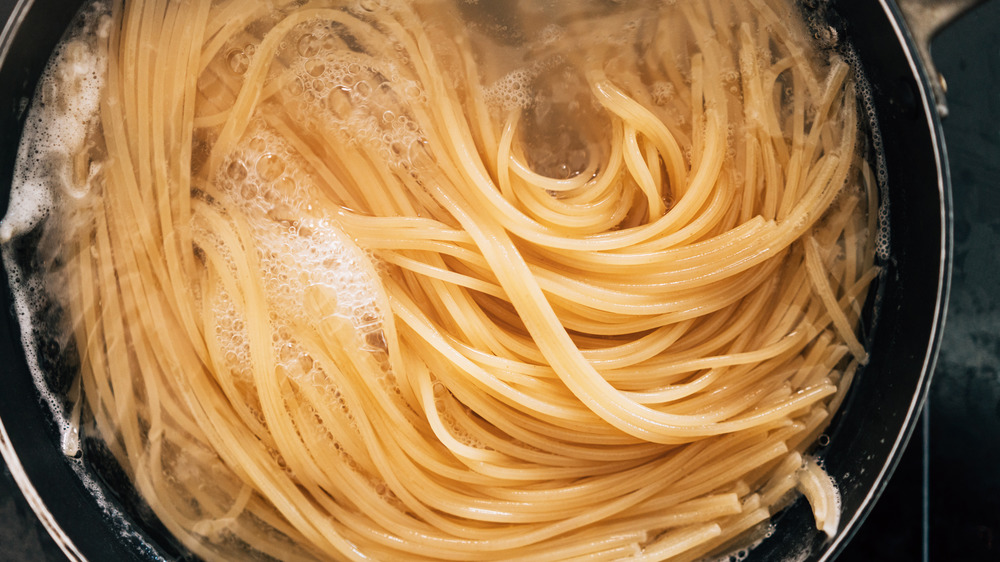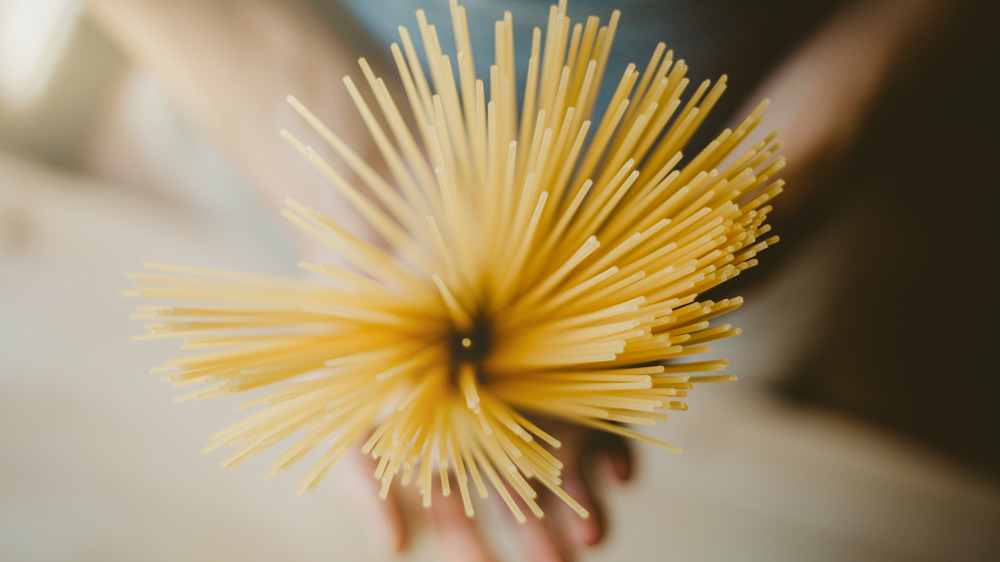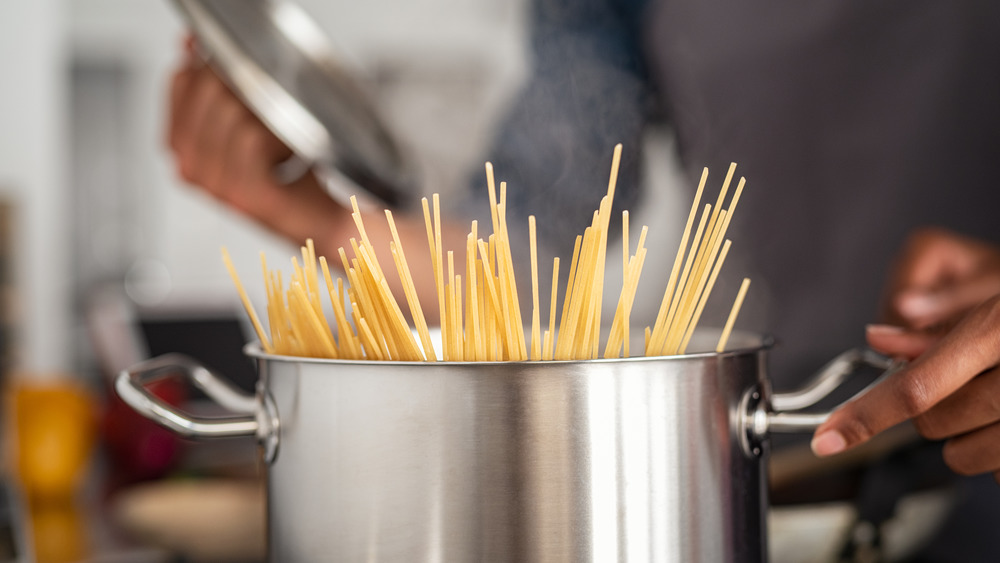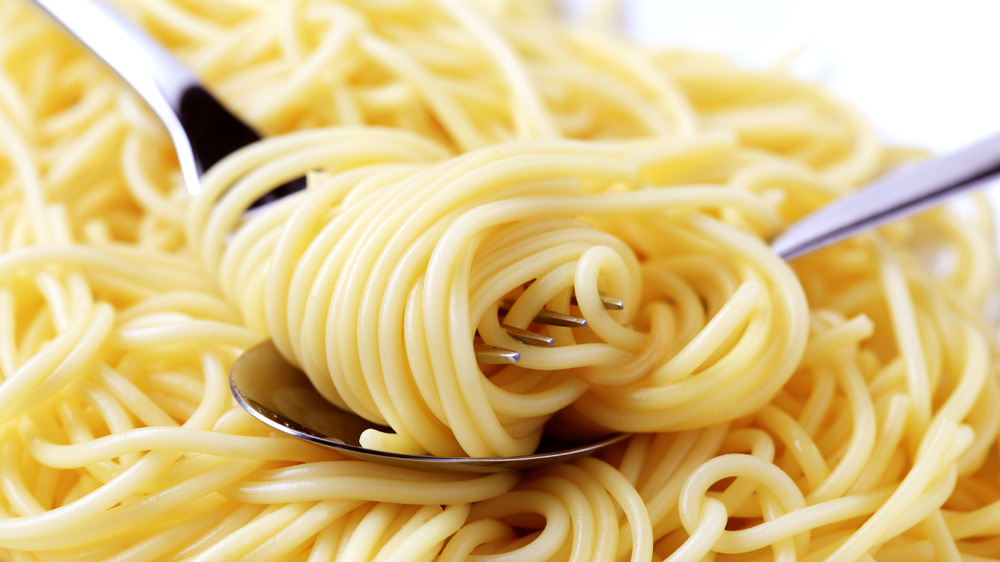The One Spaghetti Rule You Should Never Break
Pasta night is the best night of the week. Carbs, sauce (or butter if you're feeling indulgent), cheese, maybe even meatballs — it's a recipe for a deliciously comforting meal. Even better? Pasta is famously so easy to make that even the most beginner home cook can do so without burning the house down. All you have to do is heat the water, toss in the pasta of your choice, and let it cook until it's perfectly al dente, right?
Yes, in theory. But if you're opting for spaghetti instead of smaller shapes, like rotini or penne, there are certain "rules" worth following. There's one thing in particular you should never do when you're cooking up a pot of spaghetti, and it's probably something you're guilty of doing from time to time. It all has to do with the preparation. Here's what to keep in mind the next time you're making a lengthier pasta.
Don't break the noodles before cooking
The only difficulty when it comes to cooking spaghetti — or similarly long noodles, like angel hair, linguine, or fettuccine — is trying to fit those spindly, brittle sticks into a pot. Unless you have a very large steam pot, you're probably left with half of the noodles underwater and half sticking awkwardly out the top. It's tempting to snap the noodles in half so that they're all submerged safely in the pot. After all, you'd assume that will ensure they cook more evenly. However, apparently this is a big pasta faux pas.
Chef Carolina Garofani explained to Slate that the reason you should never break your spaghetti before cooking it is because the noodles are meant to be eaten by twirling them around your fork. This is difficult to do when you're left with tiny, broken-up pieces of spaghetti rather than the full noodle. The blogger behind The View From My Italian Kitchen adds that many Italians actually consider it bad luck to break pasta. So instead, stir and swirl to ensure things cook evenly. Then you'll be left with plenty of pasta to wrap in sauce!
There's a method to cooking long spaghetti noodles
If you aren't supposed to break the noodles before cooking them, what are you supposed to do? It seems like every chef, both at-home and professional, have their own opinions on the best way to cook them. However, there are some basics that most people can agree on when it comes to the perfect pot of pasta. Speaking of pots, the first step is to choose one that's big enough for your noodles. The larger the pot, the less of the long spaghetti noodles that will be sticking out the top. Real Simple suggests one that holds at least seven quarts and that's lightweight so the water boils faster.
Once you have your pot, many cooks recommend salting the water. In fact, it's one of Giada de Laurentiis' number one pasta-making tips. "The first time you get to season the pasta, which is in the water, is what's going to make the difference between a great pasta and a mediocre pasta," the Food Network star told Foodbeast. "If you don't season it with enough salt, your pasta is bland." How much salt should you add? Enough for the water to be very salty, according to de Laurentiis. "Season it like you would the sea," she says. Finally, The Daily Meal recommends stirring the noodles every so often as they cook to prevent them from sticking together (and ensuring they all get submerged in the boiling water).
Twirling spaghetti on a fork is an Italian tradition
The reason you shouldn't break spaghetti noodles is so that you can twirl them on your fork. And it turns out, the twirling method of eating pasta is a longstanding tradition in Italy — and one that requires a little practice to perfect. For starters, if you want to eat your noodles like a true Italian, you should never use a spoon to twirl your spaghetti into, according to The New York Times. This is a common practice in the U.S. (and one that many believe came from Italy) but it's actually frowned upon overseas. Instead, The New York Times recommends separating a few strands with the tines of your fork, and then using the curve of the plate to help you twirl them up.
There's one exception to the no-spoon rule: If you're eating pasta served in broth, you are allowed to use a spoon. "The twirling in a spoon is permitted in only one case," Maureen Fant, co-author of Sauces & Shapes: Pasta The Italian Way, explained to Splendid Table. "That case is when you have your angel hair, which everybody loves, in broth, which is where it's meant to be."



